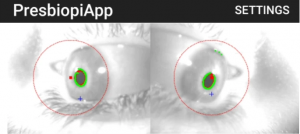Abstract
This paper presents an energy-efficient design and evaluation of a novel portable device for the automatic correction of presbyopia in human eyes driven by the use of opto-electronic lenses and based on the dynamic pupil response of the subject. Due to the wearable nature of the proposed Dynamic Auto–Accommodation Glasses, in addition to the real-time requirement, an energy-efficient implementation is critical for the success of the device. In this work, the binocular pupil tracking of a subject, followed by the calculation of the eyes’ vergence, and the control of a pair of opto-electronic lenses are implemented and evaluated on several hardware platforms, including two mobile GPU/SoCs, a high-end FPGA, a low-cost FPGA, and a desktop GPU (as a reference point). The pupil tracking algorithm has been parallelized, applying different platform-specific optimizations for each case, to design a fast yet energy-efficient wearable. The hardware platforms have been evaluated to determine which one is the most appropriate for the presbyopia correction task. The experimental results show that the most energy-efficient platform is a mobile GPU (Samsung Exynos 8890) capable of processing frames at 0.016 Joules/frame, still allowing real-time processing (24 frames/sec).


